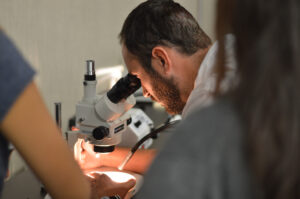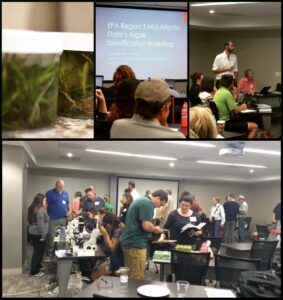Aquatic Animal and Plant Identification
Interstate Commission on the Potomac River Basin
What Lives in the Potomac?
Taxonomy is the science of classifying living organisms into increasingly similar groups or types. Correctly naming an organism can tell you who it is most closely related to and something about its behavior, its sensitivity to pollutants, and its preferred foods and habitat.
- Plankton and Macroinvertabrate Taxonomic Species Lists: Plankton and macroinvertebrate taxa lists generated from ongoing Chesapeake monitoring programs and historical datasets.
- Fish: Fish are perhaps the most well-known and charismatic members of aquatic communities and have vital ecological roles.
- Other Resources: Taxonomic keys and field guides for citizen scientists.
- 2016 Algae Workshop: Mid-Atlantic State’s algae identification workshop sponsored by EPA Region 3 (August 10, 2016).
Lists of Bugs and Algae
Plankton and macroinvertebrate monitoring programs
Species lists are routinely compiled from the sample results that ongoing biological monitoring programs share with the Chesapeake Bay Program (CBP). ICPRB works with CBP to update and maintain the following lists:
- [LINKS COMING SOON]
Chesapeake and Potomac Species Lists
In the 2000s, before taxonomic lists for the Chesapeake Bay and watershed were available online, ICPRB compiled species lists from published listings, other reports, and regional databases and routinely updated it. Listed were taxonomic names, common name if available, NODC (National Oceanographic Data Center) taxon codes version 8.0, and ITIS (Interagency Taxonomic Information System) taxonomic serial numbers for aquatic or water-related species in the Chesapeake Bay basin. The last update was done in 2007.
Freshwater Fish in the Potomac watershed
Former ICPRB staff, Jim Cummins, compiled a master list of fishes found in the freshwater portions of the Potomac, including the freshwater rivers and streams and the tidal freshwater river. However, it is not a complete list of the tidal fishes because many marine species can end up in the Potomac as incidentals. The list was last updated in 2013.
- Fishes of the Freshwater Potomac (ICPRB, 2013)
Resources
- Integrated Taxonomic Information System: Provides an accessible database with the authoritative taxonomic information on plants, animals, fungi, and microbes of North America and the world, including species names, their hierarchical classification, and their unique taxon serial number (TSN). ITIS is the result of a partnership of US and international agencies formed to satisfy their mutual needs for scientifically credible taxonomic information.
- The Atlas of Common Freshwater Macroinvertebrates of Eastern North America: The atlas is a product of Macroinvertebrates.org, an interdisciplinary research and development project to create a teaching and learning resource for aquatic insect identification which supports citizen science identification activities. Contains pictures, identification keys, and general species information.
- Phytoplankton Monitoring Network: The National Phytoplankton Monitoring Network (PMN) is a community-based network of volunteers monitoring marine phytoplankton and harmful algal blooms (HABs). PMN recognizes the interrelationships between humans and coastal ecosystems while providing volunteer citizen scientists with meaningful opportunities for hands-on science engagement. The PMN enhances the Nation’s ability to respond to and manage the growing threat posed by HABs by collecting important data for species composition and distribution in coastal waters and creating working relationships between volunteers and professional marine biotoxin researchers.
- Field Guide to Submerged Aquatic Vegetation of Chesapeake Bay: One of the Chesapeake Bay’s most significant natural resources is its bay grasses, also called submerged aquatic vegetation (SAV). This field guide shows you how to identify SAV and provides detailed illustrations and prominent identification features for each species.
2016 Algae Workshop
 In April 2016, ICPRB participated in an Algae Summit that coincided with the EPA Region 3 Water Director’s meeting. Subsequently, on August 10th of that year, the Commission hosted an EPA-sponsored workshop on algae identification.
In April 2016, ICPRB participated in an Algae Summit that coincided with the EPA Region 3 Water Director’s meeting. Subsequently, on August 10th of that year, the Commission hosted an EPA-sponsored workshop on algae identification.
Interested staff of state agencies and river basin commissions from Mid-Atlantic states took the time to familiarize themselves with the different forms of filamentous algae and underwater plants in the region through presentations and samples under the microscope.
Algae Workshop Resources:
- Slide Presentations, G. Mike Selckmann, ICPRB
- Field ID Algae Handout, G. Mike Selckmann, ICPRB
Return to Aquatic Life Main Page


